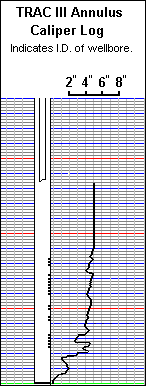

The Caliper Tool is a 3 armed device that measures the internal diameter (I.D.) of casing or open hole completions. This information is crucial to all types of production logging. The I.D. must be know in order for an accurate fluid rate to be calculated. Many people were incorrectly trained to use caliper logs on only open hole completions. They assumed the casing to be a clean, constant I.D. If we are not allowed to run a caliper, we guess the most important variable in our calculations.
The following example calculations are based on a well with 5.5" #15.5 casing and a 7/8" O.D. TRAC-III Logging String over a 5' (60") interval. Look how much a small amount of build up in the casing can affect the results. Assume a 9 second transit time from ejector to detector.
| Subject | Formula | Cubic Inches | Cu. In./BBL | BBLS/5' |
|---|---|---|---|---|
| Casing | 3.14 x (4.950"/2)² x 60" = | 1,154.65 | 10,164 | .1136 |
| (86,400 secs/day / Reaction Time sec) x V bbls = BBLS/DAY |
|---|
| (86,400 / 9) x .1101 = 1090.56 BBLS/DAY |
9 second reaction time equates to 1090.56 BBLS/Day
Now let's calculate the volume with only 1/4" build up.
| Subject | Formula | Cubic Inches | Cu. In./BBL | BBLS/5' |
|---|---|---|---|---|
| Casing | 3.14 x (4.70"/2)² x 60" = | 1,040.97 | 10,164 | .1024 |
| (86,400 secs/day / Reaction Time sec) x V bbls = BBLS/DAY |
|---|
| (86,400 / 9) x ..0989 = 983.04 BBLS/DAY |
That's a 10 percent error.
| Subject | Formula | Cubic Inches | Cu. In./BBL | BBLS/5' |
|---|---|---|---|---|
| Casing | 3.14 x (3.950"/2)² x 60" = | 735.25 | 10,164 | .0723 |
| (86,400 secs/day / Reaction Time sec) x V bbls = BBLS/DAY |
|---|
| (86,400 / 9) x .0688 = 694.08 BBLS/DAY |
Just 1" of build up gets you a 34 percent error!
As you can see, it is very important to know the I.D. An average hole size is calculated over the interval that the velocity readings are measured. This will not equal the exact diameter of flow. But, it will keep your results much closer to reality.
Another point concerning any down hole rate calculation is the degree of variation in build up. It would not be of much use to shoot a velocity shot across an interval where the I.D. varied from about 5" to less than 2". While an average hole size can be figured for rate calculations, the magnitude of various flow patterns (currents, eddies, etc.) can not be compensated for. The caliper data is just as important for placement of velocity shots as the location of perforations and zones.
Last. but not least, the most obvious reason for running a caliper is to determine wellbore mechanical conditions.
Annulus TRAC-III Page
Cardinal Welcome Page
